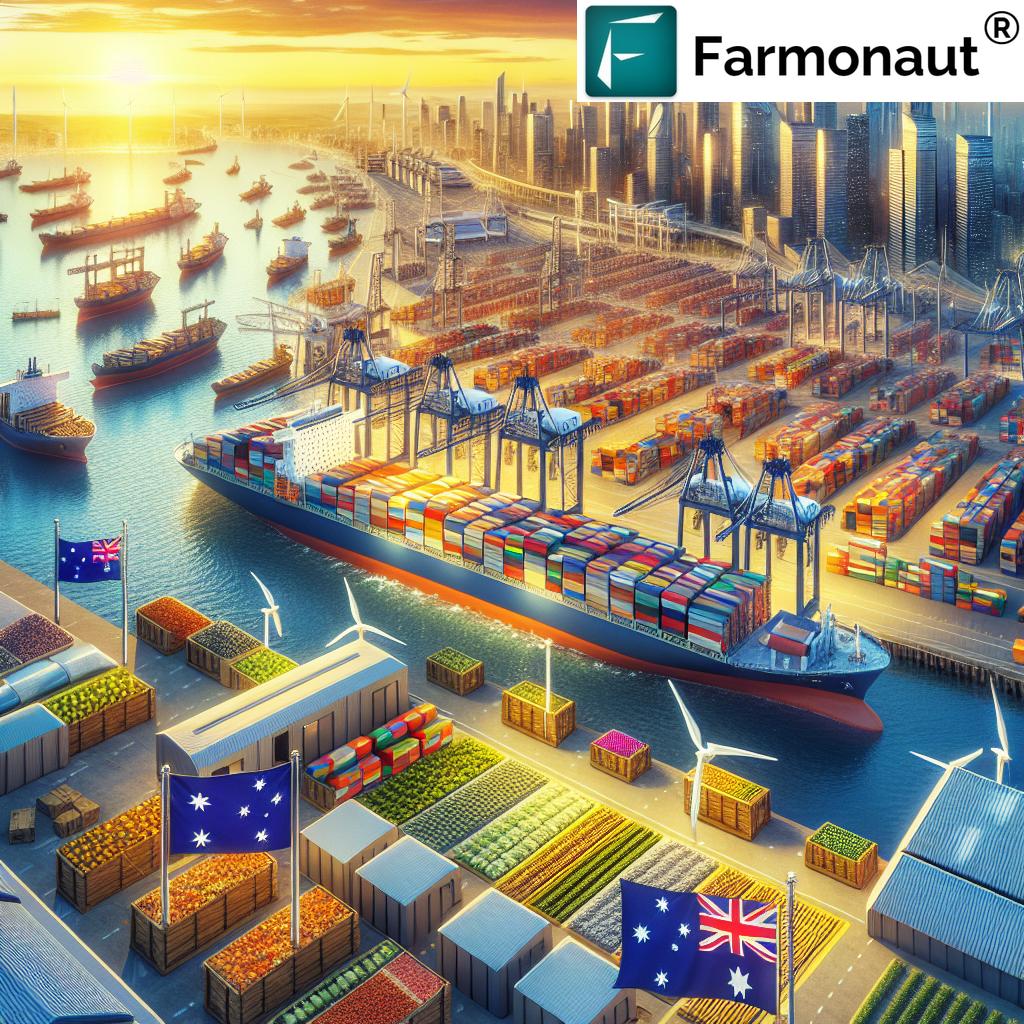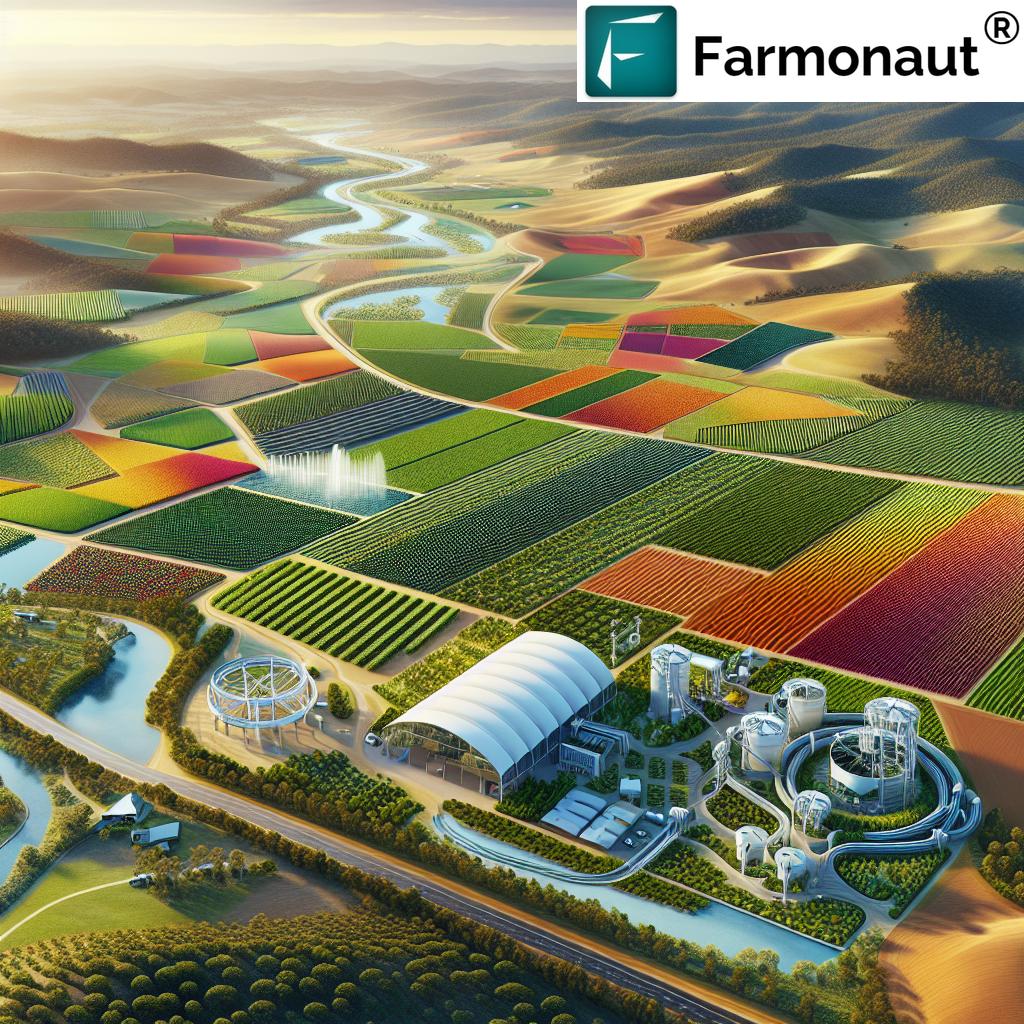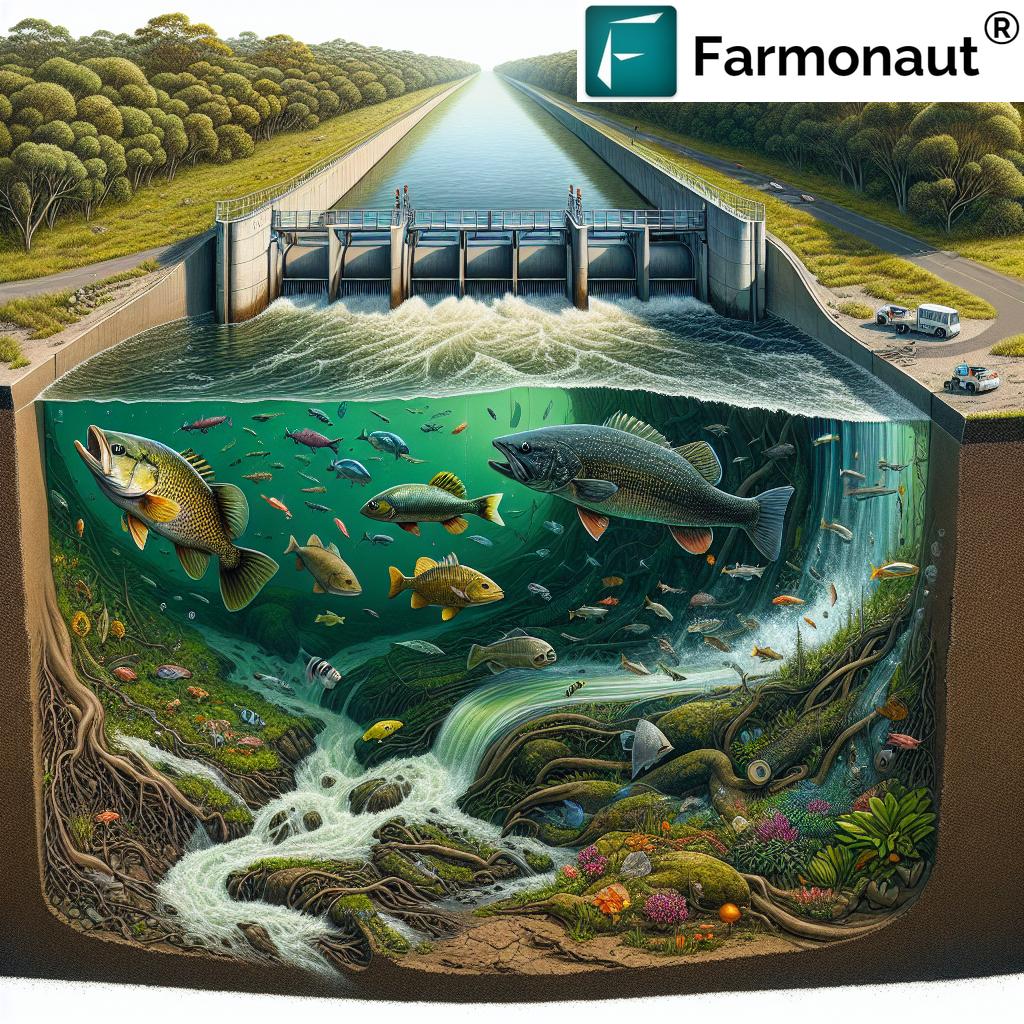Revitalizing Western Australia’s Wheatbelt: Sustainable Agriculture Through Carbon Offset Farming and Tree Planting
“Western Australia’s wheatbelt project integrates multi-species tree plantations with existing farm operations, promoting soil health and carbon offset farming.”
In the heart of Western Australia lies a region known as the wheatbelt, a vast expanse of agricultural land that has been the backbone of the state’s cereal production for generations. However, in recent years, this crucial farming area has faced significant challenges, from declining soil health to the ever-present threat of dryland salinity. Today, we’re excited to share with you a groundbreaking initiative that’s transforming the landscape of Western Australian agriculture – both literally and figuratively.
At Farmonaut, we’re passionate about innovative solutions that support sustainable farming practices. While we’re not directly involved in this project, we’re keen to explore how cutting-edge agricultural technologies can complement these on-the-ground efforts. Let’s dive into the fascinating world of carbon offset farming and tree planting in Western Australia’s wheatbelt.
The Wheatbelt Challenge: A Call for Sustainable Solutions
The Western Australian wheatbelt, stretching from Geraldton in the north to Esperance in the south, has long been the state’s cereal-growing heartland. However, decades of intensive farming have taken their toll on the land. Soil degradation, water scarcity, and the spread of dryland salinity have pushed many farmers to the brink, threatening both their livelihoods and the region’s agricultural productivity.
In response to these challenges, a visionary project has emerged, aiming to revitalize unproductive farmland through sustainable agriculture practices. At its core, this initiative combines traditional farming methods with innovative land management techniques, including carbon offset farming and strategic tree planting.

Carbon Offset Farming: A Game-Changer for the Wheatbelt
Carbon offset farming is revolutionizing agriculture in the wheatbelt. This approach involves implementing practices that sequester carbon in the soil, effectively reducing greenhouse gas emissions while improving soil health. Here’s how it works:
- Soil Carbon Sequestration: Farmers adopt techniques such as no-till farming, cover cropping, and crop rotation to increase organic matter in the soil, trapping carbon dioxide from the atmosphere.
- Reduced Emissions: By minimizing soil disturbance and optimizing fertilizer use, farmers can significantly reduce their carbon footprint.
- Economic Benefits: Participating in carbon markets allows farmers to earn credits for the carbon they sequester, providing an additional income stream.
The benefits of carbon offset farming extend beyond environmental considerations. By improving soil health, farmers can enhance water retention, reduce erosion, and ultimately boost crop yields. It’s a win-win situation for both the environment and the agricultural community.
Tree Planting Initiatives: Restoring Balance to the Landscape
Alongside carbon offset farming, tree planting has emerged as a powerful tool in the fight against land degradation in the wheatbelt. The strategic integration of trees into agricultural landscapes offers numerous benefits:
- Combating Salinity: Deep-rooted trees help lower the water table, reducing the risk of dryland salinity.
- Windbreaks and Erosion Control: Strategically planted trees protect crops from harsh winds and prevent soil erosion.
- Biodiversity Enhancement: Tree plantations create habitats for native wildlife, promoting ecosystem balance.
- Additional Income: Some tree species can provide commercial timber or other products, diversifying farm income.
The project in Western Australia’s wheatbelt is pioneering a unique approach to tree planting. Rather than converting entire farms to forestry, the initiative encourages farmers to integrate multi-species tree plantations alongside their existing agricultural operations. This model allows for the continuation of traditional farming while reaping the benefits of increased tree cover.
Long-Term Agricultural Leasing: A Sustainable Business Model
One of the most innovative aspects of this wheatbelt revitalization project is its approach to land management. The initiative introduces a long-term agricultural leasing model that benefits both landowners and the environment. Here’s how it works:
- Extended Lease Periods: Farmers enter into long-term leases, typically spanning 20-30 years, providing stability and encouraging sustainable practices.
- Integrated Land Use: The leases allow for a mix of traditional cropping and tree plantations, promoting diverse and resilient farm systems.
- Shared Benefits: Both landowners and lessees share in the profits from carbon credits and timber harvests, aligning economic incentives with environmental goals.
This innovative leasing model addresses one of the key challenges in implementing sustainable agriculture practices – the long-term nature of investments in soil health and tree planting. By providing farmers with security of tenure, the project encourages them to think and plan for the long term, fostering a more sustainable approach to land management.
“Sustainable agriculture practices in Western Australia’s wheatbelt combat dryland salinity and revitalize unproductive farmland through innovative tree planting initiatives.”
Soil Health Technology: The Foundation of Sustainable Farming
At the heart of this transformative project is a focus on soil health. Healthy soils are the foundation of productive and sustainable agriculture, and the wheatbelt initiative is leveraging cutting-edge soil health technology to drive improvements. Here’s how technology is playing a crucial role:
- Soil Mapping: Advanced soil mapping techniques, including satellite imagery and ground-based sensors, provide detailed insights into soil composition and health across large areas.
- Precision Agriculture: GPS-guided machinery and variable rate technology allow for targeted application of inputs, reducing waste and minimizing environmental impact.
- Soil Moisture Monitoring: Real-time soil moisture sensors help farmers optimize irrigation, conserving water resources.
- Microbial Analysis: Advanced testing methods assess soil microbial activity, a key indicator of overall soil health.
While Farmonaut isn’t directly involved in this project, our satellite-based crop health monitoring technology aligns well with these soil health initiatives. Our platform provides farmers with valuable insights into vegetation health and soil moisture levels, complementing on-ground efforts to improve soil quality.
Water Management: A Critical Component
In the semi-arid climate of Western Australia’s wheatbelt, effective water management is crucial for agricultural success. The revitalization project incorporates several water-smart strategies:
- Water Harvesting: Techniques to capture and store rainwater for use during dry periods.
- Efficient Irrigation: Implementation of drip irrigation and other water-efficient systems.
- Drought-Resistant Crops: Introduction of crop varieties better suited to the region’s climate.
- Landscape Rehydration: Strategic placement of trees and other vegetation to slow water runoff and increase soil moisture retention.
These water management practices not only help farmers adapt to the challenges of a changing climate but also contribute to the overall health of the regional ecosystem.
The Economic Impact: Balancing Profitability and Sustainability
One of the most compelling aspects of this wheatbelt revitalization project is its potential to deliver both environmental and economic benefits. Here’s how the initiative is creating new economic opportunities for farmers:
- Diversified Income Streams: By integrating tree plantations and carbon farming, farmers can access new markets and revenue sources.
- Improved Crop Yields: Enhanced soil health and water management lead to more productive and resilient farming systems.
- Reduced Input Costs: Sustainable practices often result in lower requirements for fertilizers and pesticides, improving profit margins.
- Access to Premium Markets: Sustainably produced crops may command higher prices in certain markets.
- Long-term Land Value: Improved soil health and environmental condition can increase the overall value of farmland.
While the transition to more sustainable practices may require initial investments, the long-term economic benefits are significant. This approach demonstrates that profitability and environmental stewardship can go hand in hand.
Comparative Analysis: Traditional vs. Sustainable Farming in Western Australia’s Wheatbelt
| Aspect | Traditional Farming | Sustainable Farming with Tree Planting |
|---|---|---|
| Soil Health | Declining due to intensive practices | Improving through carbon sequestration and reduced tillage |
| Water Management | Often inefficient, high water usage | Efficient, with improved water retention and harvesting |
| Carbon Sequestration | Low | High – est. 5-10 tons CO2/hectare/year |
| Biodiversity | Limited, monoculture dominant | Enhanced, with diverse plantations supporting wildlife |
| Crop Yield | Variable, often declining over time | Stable to increasing, more resilient to climate variations |
| Economic Benefits | Fluctuating, dependent on market prices | Diversified income streams, potential for long-term profitability increase of 15-25% |
The Role of Technology in Sustainable Agriculture
As we explore the transformation of Western Australia’s wheatbelt, it’s clear that technology plays a crucial role in enabling and accelerating sustainable agriculture practices. While Farmonaut is not directly involved in this specific project, our satellite-based farm management solutions align closely with the goals of sustainable farming initiatives.
Here’s how advanced agricultural technology can support projects like the wheatbelt revitalization:
- Satellite Crop Monitoring: Regular satellite imagery provides valuable insights into crop health, allowing farmers to identify issues early and take targeted action.
- AI-Powered Advisories: Artificial intelligence can analyze complex data sets to provide personalized recommendations for crop management, optimizing resource use.
- Precision Agriculture: GPS-guided machinery and variable rate technology enable precise application of inputs, reducing waste and environmental impact.
- Weather Forecasting: Advanced weather prediction models help farmers make informed decisions about planting, irrigation, and harvesting.
- Data-Driven Decision Making: Comprehensive farm management platforms aggregate data from multiple sources, empowering farmers to make evidence-based decisions.
At Farmonaut, we’re committed to making these advanced technologies accessible to farmers of all scales. Our platform offers:
- Real-time crop health monitoring using satellite imagery
- AI-based advisory systems for personalized farm management
- Resource management tools to optimize water and input use
- Integration capabilities with other farm management systems
Explore Farmonaut’s API for advanced agricultural data integration
By leveraging these technologies, farmers in the wheatbelt and beyond can make more informed decisions, improve resource efficiency, and contribute to more sustainable agricultural practices.
Challenges and Future Outlook
While the wheatbelt revitalization project shows great promise, it’s not without its challenges. Some of the key hurdles include:
- Initial Costs: Transitioning to sustainable practices often requires upfront investments in new equipment and techniques.
- Knowledge Gap: Many farmers need training and support to effectively implement new farming methods.
- Market Development: Establishing robust markets for carbon credits and sustainably produced crops takes time.
- Climate Variability: The region’s changing climate poses ongoing challenges for agricultural planning.
Despite these challenges, the future outlook for sustainable agriculture in Western Australia’s wheatbelt is promising. As more farmers adopt these practices and technology continues to advance, we can expect to see:
- Increased resilience to climate change and extreme weather events
- Improved regional biodiversity and ecosystem health
- Growing markets for carbon credits and sustainably produced agricultural products
- Enhanced food security through more stable and productive farming systems
The success of this initiative could serve as a model for other agricultural regions facing similar challenges, potentially transforming farming practices on a global scale.
Conclusion: A Sustainable Future for Western Australia’s Wheatbelt
The revitalization of Western Australia’s wheatbelt through sustainable agriculture practices, carbon offset farming, and tree planting initiatives represents a bold step towards a more resilient and environmentally friendly agricultural sector. By combining traditional farming knowledge with innovative land management techniques and cutting-edge technology, this project is paving the way for a new era of farming – one that balances productivity with environmental stewardship.
As we’ve explored throughout this article, the benefits of this approach are far-reaching:
- Improved soil health and productivity
- Enhanced water management and drought resilience
- Increased biodiversity and ecosystem services
- New economic opportunities for farmers
- Contribution to climate change mitigation through carbon sequestration
While challenges remain, the early success of this initiative provides hope for the future of agriculture in Western Australia and beyond. It demonstrates that with innovation, commitment, and the right support, it’s possible to transform even the most challenging agricultural landscapes into thriving, sustainable ecosystems.
At Farmonaut, we’re excited to see how technology can continue to support and enhance these sustainable farming initiatives. While we’re not directly involved in this specific project, our satellite-based farm management solutions align closely with the goals of sustainable agriculture. We’re committed to providing farmers with the tools they need to make informed decisions, optimize resource use, and contribute to a more sustainable future for agriculture.
As we look to the future, it’s clear that sustainable agriculture practices, supported by advanced technology, will play a crucial role in feeding a growing global population while preserving our planet’s precious resources. The transformation of Western Australia’s wheatbelt serves as an inspiring example of what’s possible when innovation, environmental consciousness, and agricultural expertise come together.
FAQs
- What is carbon offset farming?
Carbon offset farming involves implementing agricultural practices that sequester carbon in the soil, reducing greenhouse gas emissions while improving soil health. - How does tree planting help combat dryland salinity?
Deep-rooted trees help lower the water table, reducing the risk of salt rising to the surface and affecting crop growth. - What are the economic benefits of sustainable farming practices?
Sustainable farming can lead to diversified income streams, improved crop yields, reduced input costs, and access to premium markets for sustainably produced goods. - How does technology support sustainable agriculture?
Technologies like satellite crop monitoring, AI-powered advisories, and precision agriculture tools help farmers optimize resource use and make data-driven decisions. - What challenges do farmers face in transitioning to sustainable practices?
Challenges include initial costs, knowledge gaps, market development for new products, and adapting to climate variability.
Explore Farmonaut’s Subscription Options

For more information on how satellite technology can support sustainable farming practices, visit our API Developer Docs.
















